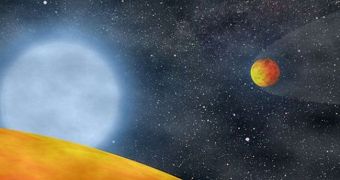Just a few days ago, astronomers operating the Kepler Telescope announced the discovery of the first two Earth-like worlds orbiting close to their parent star. That news drowned out another, revealing the existence of two additional Earth-like exoplanets around a dying star.
What is interesting about these findings is that the first two exoplanets were orbiting a brown subdwarf, a star that died a long time ago, whereas the two that were discovered more recently are orbiting a star that is currently in its death throes.
The first pair of worlds Kepler found orbits the star KOI 55, and are called KOI 55.01 and KOI 55.02. They spin around their parent star in 6.1 and 19.6 days, respectively, and experts estimate they are the stripped-down cores of former gas giants.
When their parent star passed from its main sequence to its red giant phase, its radius increased so much that it engulfed the two worlds, taking away all their gas, and leaving only their solid cores exposed. The planets should have been destroyed, but somehow they endured.
The newly-found pair of planets spins around the star KIC 05807616, at distances of just 0.0060 and 0.0076 astronomical unit. An AU is the mean distance between Earth and the Sun, or around 93 million miles (150 million kilometers), Universe Today reports.
The first planet completes a full orbit around its star in around 5.7625 hours, whereas the other one, the farthest away, takes 8.2293 hours to do the same. Their parent star is now in its post-red-giant phase.
Researchers from the United States, France, Belgium, Spain and Poland say that discovering these four exoplanets indicates that Earth-like worlds are rather common around former Sun-like stars. This certainty will increase our resolve in searching for a habitable second Earth.
Another implication of the research is that this type of world is not an anomaly, but rather a direct consequence of the stellar formation process itself. This means that any newly-formed star could theoretically act as host to such a planet.
Astronomers say that Earth-sized planets orbiting around 1 AU from Sun-like stars are the best candidates for supporting the existence of liquid water, and maybe even an atmosphere. As such, they are the most likely candidates in the search for extraterrestrial life.

 14 DAY TRIAL //
14 DAY TRIAL //